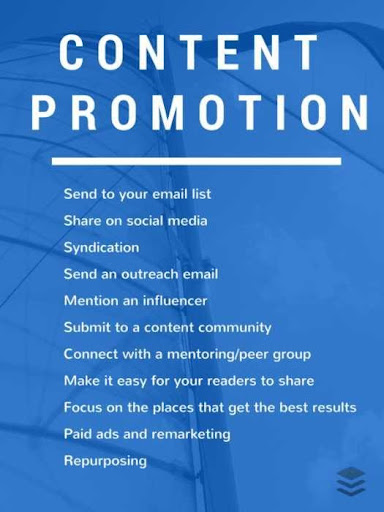
Content marketing has turned into the buzzphrase of the decade. It has dominated social media marketing forums and conferences and is fast becoming a core function of any modern-day digital marketer. That’s why, in 2022, SeoServicesBangalore.in predicts it will account for 60% of all digital marketing activity. But with so much noise about its supposed importance, finding quality content to share can be difficult.
And let’s face it – you could spend every minute trying to find brand new material to share with your audience, but that would leave you precious little time to actually run your business!
What does this mean? That you need help now more than ever if you’re going to make content marketing work for your small business. The problem is that there are too many experts with too many opinions.
That’s why we’ve put together the ultimate guide to help you make content marketing work with 17 actionable tips.
Let’s get started!
Know who you’re creating content for
Your identity is important to your business. But did you know that it can also be used to determine what content you share and the exact audience you should be targeting? When creating content for your small business, take a step back and look at how it could benefit:
- Your existing customers
- Your potential customer personas
- Non-customer personas based on demographics (e.g., gender, age group, etc.)
- The lifestyle of these 3 groups (i.e., what they do when they get online)

These will help you identify who you should be sharing content with and how best to engage them. Everyone has different interests and needs when it comes to content. But you need to know where they’re coming from before you can focus on how their problems can be solved by reading your material.
For example, it doesn’t make sense to share personal development tips with someone who is a cat-lover!
If you can’t work out how to do this, then ask someone for help. Every content marketing project needs a champion, so find someone who has expertise in your chosen niche or industry who will be able to help you. Don’t just think about the types of things that your customer personas are interested in. It’s also important to consider their preferred form of content.
For example, 70% of internet users claim they want more video content, but the vast majority are still watching text-based articles on social media or blogs.
If you don’t have a clue about what your customers are looking for online, do some research.
There are plenty of resources available for this, but one I always recommend is BuzzSumo.
The good thing about this tool is that it can help you find out what content your competitors are sharing, so why not use them as an example?
Once you have a better idea of what your audience wants, create more of it.
Remember, the aim of content marketing is to create high-quality content that builds your brand and brings in new customers. The only way you’re going to achieve this is by knowing exactly who you’re targeting and what they want.
Target topics with search traffic potential
The first step to creating a successful content marketing campaign is deciding what type of content to create. One way you can do this, and still keep things fresh and interesting, is by focusing on topics that will receive search traffic in the future. There are ways to work out what topics will be popular: Google Trends, Google’s Keyword Tool, and other third-party tools like UberSuggest and KeywordTool.io can help you with this.
Some of these tools will also give you weekly search volumes for the topic so that you know how much interest there is in it.
This helps because we’re looking at long-term trends when it comes to content creation, rather than just focusing on what’s popular. All you need to do is search for a general topic that interests you, find out what similar searches have been over the past year or so, look at their volume and then put them into a spreadsheet.
You might be surprised at just how many keywords you can find when you do this.
This is where it’s important to consider your customer personas and what they might be searching for in the future, so you can create content that appeals to them. By targeting the most popular topics in your industry with a high volume of search traffic, you’ll increase your chances of finding new customers.
Tackle competitors’ best-performing topics
Another way to find out what content is getting the most attention from your competitors and industry experts is by looking at their best-performing pieces. This can be done through a combination of SEO analysis and social listening tools.
By analyzing keywords, you’ll get a better idea of what people are searching for online and which topics to focus on when creating your own content.
Once you know what topics will eventually get the most search traffic, it’s time to turn your attention to social media. By using tools like BuzzSumo and Followerwonk, you’ll be able to see which types of content are getting the most shares via social media platforms like Facebook and Twitter.
Prioritize topics using “business potential”
Once you’ve worked out which topics will receive the most search traffic and social shares, it’s time to prioritize them by their business potential. This means ranking the topics according to how much they’re likely to benefit your brand. You can do this by considering factors like:
- How many customers a topic is likely to attract
- How many customers are already in the buying cycle
- How much time it will take to create content around a topic
To do this, you’ll need to spend some time analyzing the potential of each topic.
This might be ideal for marketing experts with plenty of experience or those who have worked on marketing projects before, but if you’re just starting out, you could always get your team involved. Make sure you consider the customer perspective to get an idea of what topics are likely to work best for your brand. You might need to do some research on the competition and industry leaders first to find out exactly how they prioritize their content.
Match key messages with topic potential
Once you’ve worked out which topics have the best commercial potential, it’s time to match them up with your brand. This means coming up with a clear-cut idea of what you want to achieve by creating content around a particular topic. If possible, try to do this before you start brainstorming ideas for content that will attract search traffic and social shares.
Once you’ve done this, you should be able to work out which topics will attract the most search traffic and social media shares as part of your content marketing plan. It’s important to note that many of these topics might not constitute blog posts or articles right away. This is where it’s useful to consider your customer personas and their problems.
By targeting the most popular topics in your industry with a high volume of search traffic, you’ll increase your chances of finding new customers.
Match the 3 Cs of search intent
Google’s objective is to provide its users with the most relevant search results for any search query. As a result, in order to rank highly on Google, you must demonstrate that you are the most relevant search result. Gone are the days when you were able to fool Google by using blackhat SEO techniques. Google is now so advanced that it will penalize your site if you aren’t delivering the content its users want.
Instead, you need to find a way to make sure Google understands what type of content best matches each search query.
Content-Type:
Google understands that there are many different types of content, each with its own ranking ability. It also knows that not all content is the same. For example, if someone performs a search for “Halloween gifts”, Google can tell instantly whether it’s looking for information on Halloween costumes or tips about where to buy pumpkins.
Content Format:
Google considers the format of content to be another key ranking factor. Just because you see ads for an eCommerce store at the top of Google’s results page, it doesn’t mean that a specific search query will rank the website highly.
When people search for “buy Halloween costumes”, it’s likely they’ll expect to see a product catalog or eCommerce store at the top of the results page. They won’t be surprised to see an actual store listed here because that’s what they’re looking for.
Content Angle:
Google also considers content angle to be another important ranking factor. You might think that you’re the best option for a particular search query, but if your offer is presented in the wrong way, you could lose out on potential customers.
For example, imagine searching for “Halloween costumes” and seeing information about scary movies instead of a product catalog or an eCommerce store.
You might be tempted to click on the search result, but if you already know what type of information you’re looking for and Google hasn’t delivered it, you’re unlikely to bother continuing your search and potentially vote against that website with a low CTR. By understanding how Google ranks and prioritizes content, you can find out which topics will attract the most search traffic.
Create a content calendar
A content calendar should be a key part of any digital marketing strategy. It allows you to create a long-term plan for your content, ensuring that you’re always meeting your customers’ expectations.
Include details such as:
- Types of content being created Dates relevant events are taking place
- Themes that will define the overall direction of the content
- Types of content that are being scheduled to attract search traffic
By creating a calendar for your content marketing, you’ll be able to plan ahead and ensure your content is relevant all year round. Learn how to easily create a content calendar by following this useful guide.

Promote your content
Publishing great content is only half the battle. You need to make sure that your content reaches the right audience, otherwise, it’s worthless.
Ensuring you have a process in place for promoting new blog posts and articles means that you can generate visibility outside of your existing customer base.
Make sure that each post has at least one strong call to action that encourages visitors to share the content on social media, comment on it or sign up for your mailing list.
This way, you can keep increasing visibility and exposing your brand name to new customers as well as bringing back those who have signed up with you before.
Design shareable images
One of the best ways to draw attention to your content is to create shareable images that are relevant to the topic at hand. If you’re promoting an article about Halloween costumes, for example, you could use an image of a Hollywood actress who is famous for her role in a scary movie.
These types of images make it easy for users to share your content and help it reach a wider audience.
It’s also possible to use images as a form of marketing yourself or your brand. For example, if your company creates Halloween costumes, you could include an image of employees most likely dressed up in the office for Halloween. This type of visual content is more likely to be shared by users, making it possible to reach new customers.
Repurpose your content
Once you’ve published a blog post, article, or video, it’s important to look for opportunities to repurpose that content. You could turn an article into a presentation and deliver this at an industry event. You could then discuss your thoughts further by creating another article based on the presentation and publishing the slides you used as well.
Repurposing existing content is a great way to maximize ROI and ensure that the effort you put into creating new content always delivers some sort of return.
Add “link triggers”
As well as providing useful content, you also need to be promoting your website. One of the best ways to do this is by adding “link triggers” that encourage visitors to click on your website URL and visit a page on their own.
For example, you could add a YouTube video at the end of a blog post that’s linked to a page on your website.
This will encourage visitors to click through and explore other content that you’ve created, helping to drive up traffic levels. Google’s algorithms have been designed with the aim of making search results relevant and useful for users. By understanding how they work, you can create a successful marketing campaign that meets those requirements.
Update your content regularly
Google is always indexing the web. This means that by updating existing content or adding new content, you can increase your website’s visibility for relevant search terms.
For example, if you published a blog post last year about “rapid prototyping services”, but now work with 3D printers as well, you could add that to the article.
This will help this particular page to rank higher in results for both the original search term as well as “3D printers”. For many people, SEO is all about trying to trick Google into ranking their content higher than it otherwise should be. But, the reality is that Google wants to provide the best possible search results for users – and ranking well is a reflection of that.
Make sure, therefore, you’re creating quality content and keeping it up-to-date. This will help to ensure your pages rank as highly as possible without resorting to tricks or trying to deceive other webmasters.
Do blogger outreach
Online marketing is a numbers game, and blogger outreach is a great way to get high-quality backlinks. Start building relationships with other bloggers in your industry, and that means. It’s not enough to blanket approach potential customers; you need to start slowly, building rapport with key decision-makers before offering anything of value.
“Forbes suggests differentiating yourself by providing insight into your company’s processes. Because these bloggers are writing an article about a topic related to yours, this increases the likelihood of users clicking through to your site and engaging with your content.
It’s also possible to use tools like Followerwonk and Buzzsumo to find influential users and bloggers and analyze their content. You can then follow them on Twitter and start a relationship that could lead to opportunities for partnership or outreach in the future.
Be opinionated
You don’t always have to create content in the form of an article: you can also reach out and offer your opinion on industry issues. As long as it’s relevant and presented in a respectful way, this can be a great way to establish yourself as an authority figure in your niche. But whatever you do, don’t be controversial for the sake of it. You’ll come across as desperate to get attention, and that’s not something you want to do!
When you do post an article about an issue in your industry, make sure you link to sources within the piece so readers can see where you got your information from. If possible, use images to support what you’re saying.
Shine new light on industry with other lenses
It’s not just about providing your own take on what’s happening in your industry. You should also be looking to uncover new angles that generate discussion among your target audience.
For example, if you’re a company that helps entrepreneurs to start their own businesses, you could conduct research into the top reasons for business failure.
Not only is this a more unique way of tackling an issue in your industry, but it’s also going to be far more interesting for your readers – and that means they’re going to engage with the content.
Don’t obsess over word count
Some of the most popular blog posts on the Internet don’t even break 600 words. So, long-form content isn’t necessarily what you need to focus on, “every time”. But if the topic you are covering needs to be explained well, then the length of your content should always be determined by the needs and interests of your target audience.
For example, if you’re looking to help website owners with SEO, then a long-form post may work best. But if you’re running a Facebook page for dogs and their owners, short videos or even “Facebook carousel” posts may be more than good.
The beauty of web pages is that they’re infinitely expandable: if users continue scrolling down a page, they’ll see more and more content as they do so. Remember, Google is driven by user experience: if a page is relevant and useful for a user’s search term, it will rank highly, even if it is not a 1500+ words blog post.
However, depending on the user search intent, if we go by the current research, longer content tends to rank higher.

The easiest way to kill your blog is to let it become a dumping ground for half-baked, rushed posts. If you don’t publish content regularly, readers won’t come back and check in with you – and that means you’ll lose them after their first exposure.
If you have a lot of content ready to go, publish it all in one sitting: that way, when users land on your page at different times throughout the day or week, they’ll see new content. It’s also worth pointing out that publishing all at once means you can work on SEO and promotion in one sitting too. That means you’re far more likely to achieve success with less effort.
Create shareable infographics and other visuals
There’s no denying the fact that images and other visual assets tend to attract far more engagement than regular blog posts. So getting creative is always going to be a smart move for any webmaster looking for increased website traffic.
You don’t need an expensive infographic design team behind you, either. There are plenty of tools available which allow you to create your own images to use on your site, without having any design skills at all.
The thing is, when you’re creating something that people can share with their friends and visitors – it’s very easy for them to do that too! So everything you produce should be designed with sharing in mind. Visual content also carries far more weight in the eyes of search engines.
So make sure your infographics are optimized for SEO too – even if they’re created using a tool like Canva or Easel.ly.
Create content hubs for your industry
Hubs are great for two reasons.
- Firstly, they make it easier for users to find the content they’re looking for on your website. This means you’ll generate more visits by directing people to where to go next after they read one of your articles.
- Secondly, and perhaps more importantly, these sorts of pages boost the SEO performance of every single post that lives within them.
- You can include links in most hub pages: this is something you should use sparingly, however – only when linking through makes sense in what you’re talking about at that given moment in time.
Conclusion:
There’s no single “right” way to use content marketing to your advantage. By understanding the different factors that impact Google ranking, you can find a way to deliver content that’s going to attract search traffic and create a long-term plan for your content marketing campaigns.
This is an article written by Vikas Solanki, a Digital Marketing Strategist from www.SeoServicesBangalore.in





